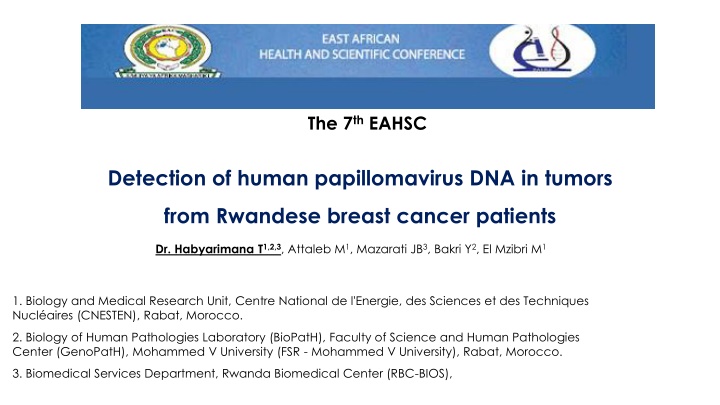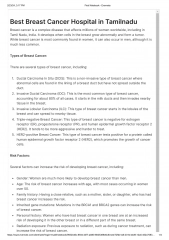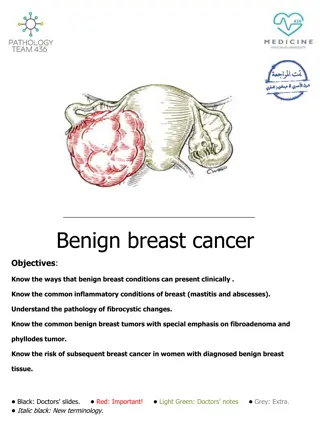Detection of HPV DNA in Breast Cancer Tumors: Study from Rwanda
This study assessed the presence of human papillomavirus (HPV) DNA in breast cancer cases from Rwanda and explored the association between HPV infection and clinicopathological features. The prevalence of different HPV types was identified through genotyping methods. Results indicated the presence of HPV DNA, particularly HPV 16 and 31, in the breast cancer tumors studied. The findings contribute to understanding the potential role of HPV in breast cancer development.
Download Presentation

Please find below an Image/Link to download the presentation.
The content on the website is provided AS IS for your information and personal use only. It may not be sold, licensed, or shared on other websites without obtaining consent from the author.If you encounter any issues during the download, it is possible that the publisher has removed the file from their server.
You are allowed to download the files provided on this website for personal or commercial use, subject to the condition that they are used lawfully. All files are the property of their respective owners.
The content on the website is provided AS IS for your information and personal use only. It may not be sold, licensed, or shared on other websites without obtaining consent from the author.
E N D
Presentation Transcript
The 7thEAHSC Detection of human papillomavirus DNA in tumors from Rwandese breast cancer patients Dr. Habyarimana T1,2,3, Attaleb M1, Mazarati JB3, Bakri Y2, El Mzibri M1 1. Biology and Medical Research Unit, Centre National de l'Energie, des Sciences et des Techniques Nucl aires (CNESTEN), Rabat, Morocco. 2. Biology of Human Pathologies Laboratory (BioPatH), Faculty of Science and Human Pathologies Center (GenoPatH), Mohammed V University (FSR - Mohammed V University), Rabat, Morocco. 3. Biomedical Services Department, Rwanda Biomedical Center (RBC-BIOS),
Background Epidemiology of BC Incidence Mortality North Africa: North Africa: 34.4 per 100,000 women 17.4 per 100,000 women Central Africa: Central Africa 26.8 per 100,000 women 14.9 per 100,000 women Western Africa Western Africa 38.6 per 100,000 women 20.0 per 100,000 women Eastern Africa Eastern Africa 30.4 per 100,000 women 15.6 per 100,000 women Southern Africa Southern Africa 38.9 per 100,000 women 15.5 per 100,000 women The incidence of BC in Africa is expected to double by 2050 Precise incidence figures in Africa are lacking in most countries. 2
Background BC risk factors Endogenous risk factors involved in carcinogenesis Exogenous factors involved in carcinogenesis (Genetic susceptibility) 18% infectious agents 12% viral infections 33% in Africa 3
Background HPV in cancer HPV in cervical cancer The oncogenic mechanisms used by HPV to induce CC Alpha group 5, 6, 7, 9 and 11 Model for HPV in BC 30 HPV types HR-HPV: 16, 18, 31, 33 LR HPV: 6, 11, 40, 42 4
Objective The study aimed to assess the presence of HPV DNA in breast cancer cases from Rwanda and to evaluate the association between HPV infection and clinico-pathological features. 5
Materials & Methods 47 archived BC FFPE tissues (25-74 years old) HPV detection Gene Primer MY09 MY11 GP5+ GP6+ Sequence 5 3 Size (Bp) CGTCCMARRGGAWACTGATC GCMCAGGGWCATAAYAATGG TTTGTTACTGTGGTAGATACTAC CTTATACTAAATGTCAAATAAAAA 450 L1 Nested PCR 150 HPV Genotyping HPV Genotyping by DNA by DNA sequencing sequencing 6
Results Prevalence of HPV DNA HPV types HPV31 2 (9.09% ) HPV HPV + HPV16 17 (77.27%) HPV33 3 (13.64% ) N=47 25 (53.19%) 22 (46.81%) BLAST analysis HPV Types NCBI accession Number Identity (%) DQ448212.1 JN617890.1 AF548831.1 KF921508.1 KU961844.1 LC155223.1 HM596509.1 DQ448212.1 DQ448213.1 98 100 99 100 100 100 100 98 99 16 In BC 31 33 7
Results Distribution of HPV status according to clinico-pathological features 8
Results Distribution of HPV status according to intrinsic molecular subtypes HPV HPV + Total P (N=25) (N=22) Luminal A Luminal B TNBC Her 2 Unknown 21 10 9 6 1 9 7 5 3 1 12 3 4 3 0 0.39 9
Conclusion and Future directions 46.81% of BC cases were HPV positive with HPV16 the most predominant (77.27%) The prevalence reported in other studies, ranged from 12 to 23% HR-HPV infections could be a risk factor associated with human BC development 10
Conclusion and Future directions An improved understanding of potential biomarkers should provide promising BC biomarkers for better stratification Rwandese population and allow a better design and implementation of national BC program. Effective biomarkers could enhance - Tertiary prevention through the reduction of morbidity - Secondary prevention through early detection of disease, and - Primary prevention as a risk marker to reduce overall BC incidence. Further large-scale studies and multivariate are needed to provide more consistent conclusions and recommendations. 11























